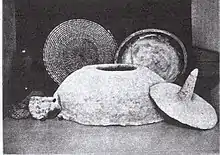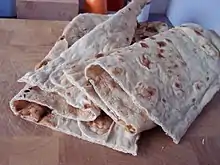.JPEG.webp) Taboon bread, main component of musakhan | |
| Type | Flatbread wrap |
|---|---|
| Place of origin | Middle East |
Taboon bread (Arabic: خبز طابون, romanized: khubz ṭābūn) is Levantine flatbread baked in a taboon or tannur 'tandoor' clay oven, similar to the various tandoor breads found in many parts of Asia. It is used as a base or wrap in many cuisines, and eaten with different accompaniments.[1]
Variations

Taboon bread is an important part of Palestinian cuisine,[2][3][4] traditionally baked on a bed of small hot stones in the taboon oven.[5] It is the base of musakhan, often considered the national dish of Palestine. Gustaf Dalman, a German orientalist, documented its making in Palestine in the early 20th-century, among other types of breads.[6] In Palestine, folded flat-bread was often filled with a spinach and onion mixture, or with cheese curds and onion mixture, or with raisins and pine nuts.[6] The ordinary taboon-bread was slightly smaller in size than the ordinary tannur-bread.[7] Over the centuries, bread-making in communal taboons played an important social role for women in Palestinian villages.[5]
In Israel, a popular flatbread known as laffa, Iraqi pita, or in Jerusalem ashtanur,[8] is typically baked in a tannur or taboon.[9][10] It is common at bakeries, and at food stands where it is mostly used to wrap shawarma or other food.
See also
References
- ↑ Skloot, Joe (February 28, 2002). "Falafel: Ambassador of peace or cuisine from mideast?". The Daily Princetonian. Archived from the original on 2009-08-19. Retrieved 2018-12-06.
{{cite web}}: CS1 maint: unfit URL (link) - ↑ Albala, K. (2011). Food Cultures of the World Encyclopedia. Greenwood. pp. 28–29. ISBN 978-0-313-37626-9. Retrieved 2019-10-03.
- ↑ Whittemore, William Meynell (1874). Sunshine, conducted by W.M. Whittemore [and others]. p. 6 – via Internet Archive.
- ↑ Albala, K. (2016). At the Table: Food and Family around the World: Food and Family around the World. ABC-CLIO. p. 171. ISBN 978-1-61069-738-5. Retrieved 2019-10-03.
- 1 2 "e-turathuna-Tabun - Bethlehem University". www.bethlehem.edu. Archived from the original on 2019-02-03. Retrieved 2019-02-03.
- 1 2 Dalman, Gustaf (1964). Arbeit und Sitte in Palästina (in German). Vol. 4 (Bread, oil and wine). Hildesheim. pp. 114–115. OCLC 312676221.
{{cite book}}: CS1 maint: location missing publisher (link) (reprinted from 1935 edition) - ↑ Dalman, Gustaf (1964). Arbeit und Sitte in Palästina (in German). Vol. 4 (Bread, oil and wine). Hildesheim. OCLC 312676221.
{{cite book}}: CS1 maint: location missing publisher (link) (reprinted from 1935 edition), Diagram 30 - ↑ Eating pious pastries in Mea She'arim, Haaretz
- ↑ Nadav, Sarah. "Let's meat at Aish: This off-the-beaten-track restaurant specializes in Eastern-style meats and delicious salads". The Jerusalem Post. Archived from the original on 2018-03-20. Retrieved 2020-01-08.
- ↑ "Did You Know? Israeli Cuisine" (PDF). jewishfederations.org. Embassy of Israel, Washington, D.C. 2010-09-04. Archived from the original (PDF) on 2014-11-06. Retrieved 2012-02-13.
